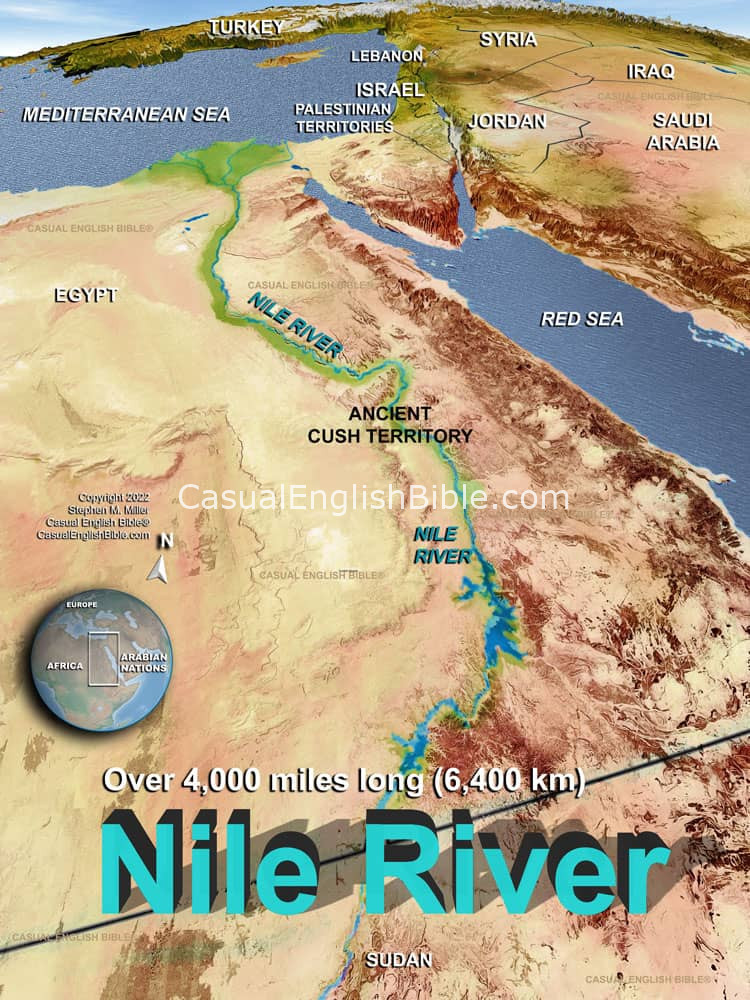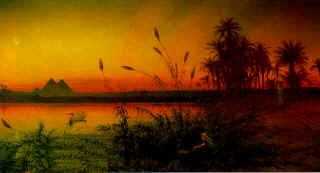

Many of the Biblical references to the Nile are found in the Pentateuch, particularly in the Joseph narrative and the account of the Exodus, but there are also a number of references in the prophetic writings.

The coincidence of the heliacal rising of the Dog Star, Sirius (Sothis), and the beginning of the inundation gave rise to the chronological unit of 1460 years, called the Sothic cycle. In addition to providing many of the necessities and some of the pleasures of life, the Nile by its regular annual inundation was the basis of the practical agricultural calendar. In ancient times the recognition of dependence on the river lead to the deification of the stream under the figure of the god Hapi, represented as a well-fed man with pendulous breasts, bearing offerings of the products of the river. culture many of its characteristic features. The Nile touched nearly every facet of Egyp. It would be difficult to exaggerate the importance of the river for Egypt. The river carved the valley and laid down the alluvium, which gave Egypt its ancient name, Kemet, “Black Land,” as contrasted with the redness of the desert. In antiquity Hecataeus, echoed by Herodotus, declared that Egypt is the gift of the Nile. In antiquity there were seven estuaries of the Nile in the Delta, but today there are only two, the Rosetta in the W and the Damietta in the E.
#Nile river bible definition series#
to the S is the Sadd el Aali, “the High Dam.” Between Aswan and the Mediterranean the water is controlled by a series of barrages. Just above Aswan is the famous Aswan Dam and a few m. From the third Cataract N the Egyptians in ancient times maintained a number of fortresses and settlements.

Between the fourth and third cataracts are the remains of Napata, the center of the so-called Ethiopian (25th) dynasty of Egypt. to the Mediterranean without receiving the waters of any other stream. The last tributary of the Nile, the Atbara, enters from the E thereafter the Nile continues some 1500 m. From here to Aswan lies Nubia, where salvage archeology attracted world-wide cooperation at the time of the building of the High dam. Below the sixth cataract are the ruins of Meroë, the capital of the Meroitic Empire, c. A short distance N of Khartoum is the sixth cataract, the first of those natural barriers which were numbered from N to S in the order of their discovery. The Blue Nile also carried much of the alluvium responsible for the creation and renewal of the soil of ancient Egypt. At Khartoum the White Nile is united with the Blue Nile, which provides the greater part of the annual flow of the united river and during flood season has twice the volume of the White Nile. The Bahr el Jebel is joined at Lake No by the Bahr el Ghazal, “the river of the gazelles” after this junction the river is called the White Nile. The river passes through shallow Lake Kioga, plunges down Murchison Falls, and enters Lake Albert, from which it emerges shortly as the Bahr el Jebel, “the river of the mountain.” South of Lake No are large swamps where floating masses of vegetation called sudd used to block the stream upon occasion and were the often fatal deterrent of early explorers of the river. Though sources may be traced farther S, it may be said that the White Nile stream begins at Lake Victoria, whose only outlet is the Victoria Nile, which exits on the NE, over Ripon Falls.Ĭourse and tributaries. The ultimate origin and the meaning of the name Nile are unknown (Gr. It was also simply itrw, “river,” from which the Hebrews derived the term יְאֹֽר, יְאֹ֖ור, “river,” the name for the Nile in the Heb. To the ancient Egyptians the Nile was Hapi, which was also the name of the rivergod. It is in the latter reaches that the Nile fostered in Egypt one of the oldest and most long-lived civilizations of which the Western culture is in direct line of descent. Rising in a region of mountains, lakes, and seasonal rains, it traverses marshy and tropical areas and eventually threads its way through rocky desert wastes, where its waters have afforded the sole basis for the existence of living things. from its sources in equatorial Africa to its delta on the Mediterranean Sea. The Nile River is one of the great rivers of the world and, in terms of length of the main stream, it is the longest of all rivers, covering some 4,160 m.


 0 kommentar(er)
0 kommentar(er)
